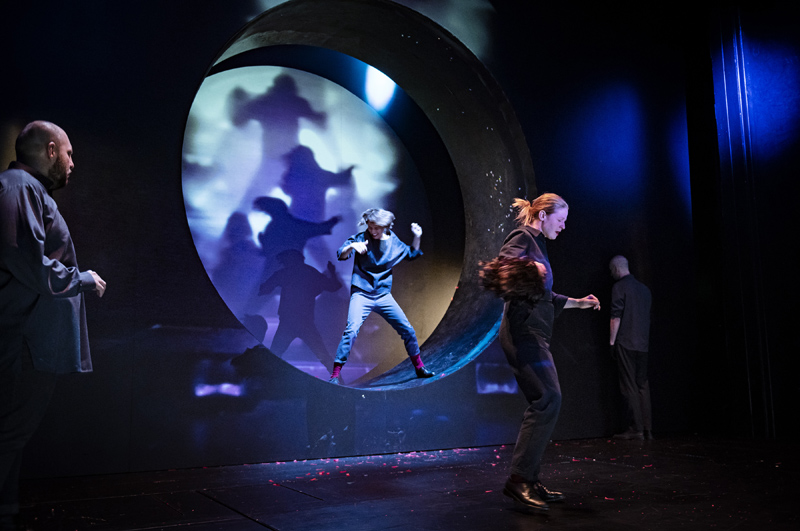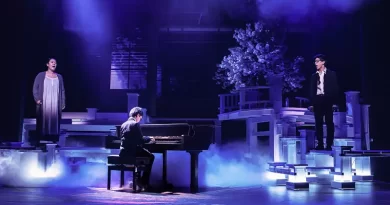“Katharina Blum”, Stadttheater, Konstanz
Dana Rufolo in Germany
18 March 2022
It is a relief that Franziska Autzen, the director of Katharina Blum oder: Wie Gewalt entstehen und wohin sie Führen Kann (The Lost Honour of Katharina Blum, or: How Violence Develops and Where it Can Lead) playing at Germany’s Stadttheater Konstanz (State Theatre of Constance) did not convert this piece – based on Heinrich Böll’s 1974 eponymous novel – into a self-serving Regietheater performance.

Ioachim-Willhelm Zarculea, Johanna Link, Hanna Eichel
and Sebastian Haase. Photo credit: Ilja Mess.
The novel from which Autzen and Hannah Stollmayer adapted the play was published during the era of the Baader-Meinhof group in Germany (c.1970) and protest movements in the United States which had veered into violence – the most notable being the San Francisco bank holdup involving Patty Hearst (1974) and the anti-war bomb that unwittingly caused a death on the campus of the University of Wisconsin at Madison (1970) – to say nothing of the counter-movement’s deadly shooting by Ohio National Guards of unarmed student protesters at Kent State University, also in 1970.
By today’s standards, the novel is a comparatively mild indictment of the sensationalism of the tabloid press of that era. In that respect, Katharina Blum is similar to Ink, the play by James Graham directed by Rupert Goold in 2017 that opened at London’s Almeida Theatre and (set in 1969) traces the rise of Rupert Murdoch.
If Autzen had attempted to cannibalize the play by setting it within the misinformation capacities of today’s digital cyberspace, it would have been a serious betrayal of Böll’s themes. It seems to anticipate the rise of social media and accompanying fake news and social bullying but it is people who are fraudsters, not yet systems. And it fades in comparison with the dramatic reality of the mind-bogglingly murderous war taking place now in the sovereign country of Ukraine and the relentless campaign of misinformation that is being waged by the Russian state to intimidate and coerce its own citizens into believing war is necessary.

Ioachim-Willhelm Zarculea. Photo credit: Ilja Mess.
Katharina Blum traces the responses of Blum and people dear to her once they understand that they have been falsely represented in order to appear more radical and extra-ordinary to the readers of a mass circulation tabloid. The tabloid Böll had in mind is the still-marketed Bild Zeitung. [Böll, German winner of the Nobel Prize for Literature in 1972, writes in his preface to the book: “Should the description of certain journalistic practices result in a resemblance to the practices of the Bild-Zeitung such resemblance is neither intentional nor fortuitous, but unavoidable.” (English translation by Kurt Andersen).]
The Constance theatre’s Katharina Blum staged the narrative of the novel impeccably in a neutral grey-tone decor with similarly bland costumes (Ute Radler) that lift it out of specificities of time and place. Four actors, two men and two women – Hanna Eichel, Sebastian Haase, Johanna Link, and Ioachim-Willhelm Zarculea – interchangeably played the range of roles, with Katharina represented by both female and male actors.
Katharina innocently met a man at a costume party at her godmother’s home during Carnival; she fell in love with him and understood he was wanted by the police only in the morning of their one-night tryst when he had to flee in the style of Simon & Garfunkel’s escapee in “Somewhere They Can’t Find Me”.
Katharina, a retiring and modest young person, is transformed into an evil woman, a criminal’s long-term moll, by a muckraking male journalist. He pressures her relentlessly and distorts what she and her defenders say. These defenders include the couple for whom she works as housekeeper; they are introduced to us on stage talking to each other from swinging chairs that are suspended inside a circular upright rotating treadmill empty of internal support struts that is built into the forestage and offers a window onto action occurring stage rear and which the actors can turn by walking on its rim.

Ioachim-Willhelm Zarculea, Johanna Link, Hanna Eichel
and Sebastian Haase. Photo credit: Ilja Mess.
The couple share a deep affection for Katharina, but the journalist reports their statements falsely so the opposite appears in print. Similarly, the journalist visits Katharina’s elderly mother incognito when she is recovering in hospital from a surgical intervention and misrepresents the case to the ill woman to the point where she becomes agitated and dies unexpectedly. The play concludes with the sound of gunshot; Katharina shoots the journalist responsible for the slanderous shaming so as to regain her “honour”.
One of the most interesting challenges to the director and cast must have been how to represent Katharina’s personality. With the four actors often lining up on the forestage for speeches addressed directly to the audience, as well as scenes on the treadmill and yet others seen through the large circular centre of the treadmill, the acting style was presentational and frontal – characteristically a German style of acting that is heavily influenced by what is labelled Brechtian theatre. The story was being told; the message was unambiguously passed on. Form fits function, as this style lent the sense that the characters were written-up newspaper accounts of personalities brought to life on the stage.
However, it is the character of Katharina Blum which I wish to focus on here. Especially because she was impersonated by a variety of actors, Katharina’s shyness was totally masked. She never “acted” embarrassed and humiliated; she always delivered her lines with a clear, unquivering, and almost didactic voice.
Blum’s distinctive character trait in both the book and the play is her willingness to tell the truth about all aspects of her life with naïve disregard for how her words facilitate her being turned into a journalistic or legalistic target. Although social norms these days do not encourage displays of bashfulness, blushing is a fundamental biological response accessible to all humans according to Charles Darwin. The naively shy character has been famously represented on stage in Tennessee Williams’ The Glass Menagerie (1945) and on film in Ava Gardner’s portrayal of a young girl in love in The Barefoot Contessa (1954). Johann Wolfgang von Goethe’s Gretchen in Faust, Part One (1808) is similarly instinctively truthful and bashful.
While we intuit a complex psychological life to Katharina – for instance, clearly she felt safe at her godmother’s and thus was open to falling in love with someone she met there – in this “reportage” style of presentation we are not able to attribute psychological depth to Katharina’s character. She is distinct from the other characters not because of any embodied emotions or animated facial expressions but only because the words she utters are different from the words the other characters say.
I wonder what would happen if you put a Laura on stage and told her to play Katharina. The result might well be a more profound theatrical experience with a troubled audience discerning the potential horror of fake news on an emotional level for perhaps the first time.









